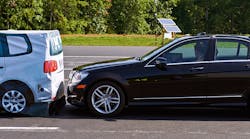The National Highway Traffic Safety Administration (NHTSA) and the Insurance Institute for Highway Safety (IIHS) recently finalized a deal with 20 automakers to make automatic emergency braking (AEB) systems a standard feature on virtually all new cars by the end of 2022, followed by light and some medium trucks in 2025.
Automakers party to the deal include: Audi, BMW, Fiat Chrysler Automobile (FCA), Ford Motor Co., General Motors, Honda, Hyundai, Jaguar Land Rover, Kia, Maserati, Mazda, Mercedes-Benz, Mitsubishi Motors, Nissan, Porsche, Subaru, Tesla Motors Inc., Toyota, Volkswagen and Volvo Car USA.
NHTSA said AEB will become standard through this agreement on most light-duty cars and trucks with a gross vehicle weight (GVW) of 8,500 lbs. or less beginning no later than Sept. 1, 2022. AEB will be standard on virtually all trucks with a GVW between 8,501 lbs. and 10,000 lbs. beginning no later than Sept. 1, 2025.
NHTSA estimates that the agreement will make AEB standard on new cars three years faster than could be achieved through the formal regulatory process.
“We’re getting these safety systems into vehicles much faster than what would have been otherwise possible,” said NHTSA Administrator Mark Rosekind in a statement. “A commitment of this magnitude is unprecedented, and it will bring more safety to more Americans sooner.”
IIHS Executive Vice President and Chief Research Officer David Zuby noted that AEB systems help prevent crashes or reduce their severity by applying the brakes for the driver.
Using vehicle-based sensors such as radar, cameras or lasers to detect an imminent crash, the system can both warn the driver and apply the brakes if the driver does not take sufficient action quickly enough, he said.
“The benefits of this commitment are far reaching,” Zuby added. “From injuries and deaths averted to the recovery of productivity that would otherwise be lost in traffic jams caused by the crashes prevented.”
IIHS Board Chairman and CEO of American Family Insurance Jack Salzwedel pointed out that lower insurance premiums could be another long-term benefit of this technology.
“Deploying AEB on a wide scale will allow us to further evaluate the technology’s effectiveness and its impact on insurance losses, so that more insurers can explore offering discounts or lower premiums to consumers who choose AEB-equipped vehicles,” he explained.



